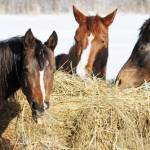Fiber: An Important Component in Equine Nutrition

Fiber is a nutritional term used frequently in human and equine nutrition, but exactly what is fiber? Are all types of fiber equally used by the horse? The general term fiber includes both digestible and indigestible fibers and does not distinguish between how much energy a horse can derive from them.
Put another way, fiber loosely describes structural carbohydrates. A plant is made up of cells, and each cell has a cell wall made primarily of structural carbohydrates. The cell walls are called structural because they give the cell shape and strength, which keep cells from looking gelatinous. The contents of the cell are mostly nonstructural carbohydrates.
Indigestible fibers are also found in cell walls. These cannot be broken down by the microbial population and have no nutritional value except as a laxative to help the progression of the digested material through the tract. In general, the stiffer or more inflexible the plant component, the more indigestible fiber present. For example, the rigid stems of alfalfa (lucerne) plants are high in indigestible fiber, while the soft, pliable leaves are rich in digestible fiber.
The amount of digestible fiber found in fresh forage and hay is generally between 30 and 50%. If feed is 100% digestible fiber, it causes stagnation problems in the tract and can lead to serious gastrointestinal disorders like enteritis or colic.
Commercial horse feeds commonly contain other high-fiber ingredients. Some are excellent sources of digestible fiber and others are not. Beet pulp and soyhulls have become commonplace in commercial horse feeds or as standalones in horse diets because they are high in digestible fiber—between 75 and 80%. Uncommon products that are reasonably high in digestible fiber are sunflower hulls, almond hulls, and citrus pulp, but palatability issues in horses keep their use limited. Other feed ingredients that are high in fiber but low in digestible fiber are cottonseed hulls, peanut hulls, oat hulls, and rice hulls. These have very little nutritional value for horses.
Benefits of high-fiber diets
Because horses are plant-eating mammals, they have a remarkable symbiotic relationship with microbes in their gastrointestinal tract that assist in digesting plant material. Without these bacteria, protozoa, and yeasts to break down cellulose molecules, horses would not derive any benefit from eating fiber. The key to maintaining an efficient microbial population is a steady supply of fermentable products. The horse’s digestive tract is designed to handle lots of fiber and thrives best if it has a variety of fiber types to feed the different microbes in the gut.
Volatile fatty acids (VFA) are created through fermentation. These short-chain fatty acids are easily absorbed into the bloodstream and are used as readily available energy to fuel various body processes. The VFA produced are primarily acetate, propionate, and butyrate. Fortunately, propionate can be converted to glucose in the liver to be used as an energy source for the brain, which can only use glucose. Since this process is not rapid, it does not result in large enough surges in blood glucose to stimulate significant pancreatic release of insulin. As with any energy source in the body, if there is excess it can be stored away as fat for use when the energy supply does not meet demand. This is why a horse can maintain optimal body condition or become obese on forage alone.
Because the digestive tract is specifically engineered to handle fiber, perhaps fiber could be thought of as an ideal way to fuel horses. Feeding forage is considered a safe way to supply energy to the horse because it is a slow process and does not cause rapid changes in blood glucose or insulin.
Forage is an obvious source of fiber, but things like beet pulp and soyhulls may not be as apparent. These are called super fibers because they contain even more fermentable material per gram than hays and are therefore excellent energy sources. High-fiber commercial products use super fibers because they pack more calories and are manageable during feed manufacture.
Unfortunately, fiber sources are not as calorie-dense as starch, which is why starches were favored originally. Fat is the other energy source that usually goes hand in hand with high-fiber feeds, because it can increase the energy density without adding bulk. Like fiber, fat does not have an effect on blood glucose and insulin release.
How high is high-fiber?
Forage is naturally high in fiber, but how do you know if a commercial feed is a high-fiber feed? The only nutrient specification on the feed bag or tag that begins to give a hint is crude fiber or fiber. Instead, look for these ingredients, which are usually indicative of a high-fiber feed: beet pulp, soyhulls, alfalfa, almond hulls, and citrus pulp. Ingredients like oat hulls or rice hulls will also increase the fiber value but are high in indigestible fiber and are not a useful source of fiber or energy.
So how high is high? Most high-fiber feeds have a crude fiber value of 12 to 25% on the guaranteed analysis. Many of these feeds will have added fat to help raise the energy so it is in line with that of a high-starch feed. Usually in the form of oil, the fat included in most high-fiber feeds ranges between 6 and 12%.








